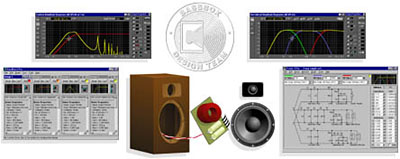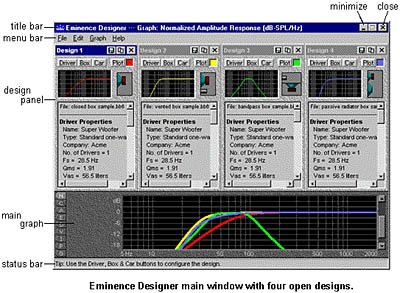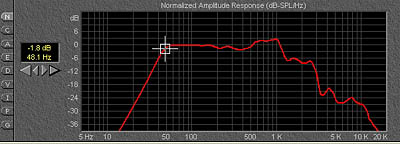|
Eminence Designer By Dick Olsher
If you are in the market for an affordable and easy to use loudspeaker design software, do give Eminence Designer (ED) a close look. It was developed by Harris Technologies, Inc., for Eminence Speaker and is compatible with PCs running Windows 95, 98, Me, NT4, 2000 or XP. Essentially, ED represents an OEM version of Harris Technologies' BassBox Lite and the two programs are functionally the same. However, as a bonus, ED includes an Eminence driver library, while no such library is bundled with BassBox Lite. ED takes aim at a wide cross section of loudspeaker constructors, including Do-It-Yourself hobbyists and semi-pro automotive, PA, and home theater custom installers. Its primary function is to assist in the design of woofer enclosures. No prior knowledge of electrical engineering or acoustics is assumed. The on-screen manual guides you through the design process with several well-conceived examples, starting with the simplest design (closed box) and progressing to the most complex (bandpass). I'm certain that anyone who knows the difference between a woofer and a tweeter would confidently negotiate the design process after a learning curve of about two hours. This is no toy, but a serious design tool that gives accurate results within the framework of the Thiele-Small (T/S) parameter model. Neville Thiele and Richard Small revolutionized the art of woofer enclosure design in the 70s by recognizing that the woofer and enclosure form a high-pass network that can be analyzed in terms of electrical filter theory. Richard Small showed how acoustic performance can be predicted on the basis of a few easy to measure parameters. The minimum driver parameters required are Fs, Vas and Qts. The free-air resonance frequency (Fs) of the woofer is measured, as you might expect, outside of the box preferably suspended free in air. The acoustic compliance (Vas) is defined as the volume of air having the same compliance or "springiness" as the woofer's suspension. It may be measured by mounting the woofer in a test box and noting the change in the woofer's resonance frequency. Or alternatively, Vas is measured by determining the change in the woofer's resonance with and without a test mass fixed to the cone. The driver's Qts refers to the total Q of a driver at Fs considering both electrical and mechanical damping. The term Q in general refers to the sharpness of a resonance and is affected by the size of the magnet (electrical damping) and the resistance of the suspension (mechanical damping). I am not suggesting that a prospective designer needs to undertake such measurements himself: just about all driver manufacturers include in their product specifications a full suite of T/S parameters, which represent nominal values for a particular model. For a full analysis, ED also requires values for the maximum linear cone excursion (Xmax), the diaphragm or piston area of the woofer (Sd), the DC resistance of the woofer's voice coil (Re), the effective voice coil inductance (Le), the electrical Q (Qes) of a driver at Fs considering only its electrical resistance, the nominal impedance (Z), and the maximum electrical power rating (Pe). Again, these parameters represent basic spec sheet information. The Eminence driver library bundled with ED already includes all of the parameters necessary for a complete ED analysis. Keep in mind that the basic T/S model does not account for changes in parameter values with drive signal level and extreme voice coil heating. The model is most appropriate for what has been dubbed "small-signal" analysis when the woofer is operated at low-power levels. ED generates system frequency, impedance, phase and group delay responses, all of which should be interpreted as valid under small-signal operation. ED also performs some large-signal analysis by providing graphs to assess response for a desired input power or voltage in terms of amplitude, cone displacement, and vent air velocity. However, the amplitude plots do not consider the impact of power compression due to voice coil heating and non-linearity of the woofer suspension. Neither does the basic T/S model include the effects of the acoustic environment - the room or space into which the woofer radiates. However, ED provides a means of including low-frequency "room gain" in the analysis. There are two modes that may be optionally selected for the acoustic environment: architectural and automotive. In the context of an automotive installation, it is essential to account for the effect of the environment as most automotive interiors have a 12dB/octave low-frequency rise that begins at about 50Hz. Obviously, this can have a major effect on the design of a low-frequency enclosure. In the automotive (car) mode, only a 12dB/octave rise may be modeled. In the architectural (room) mode, six low-frequency filters are available: 3dB/octave rise, 6dB/octave rise, 12dB/octave rise, 3dB/octave shelf, 6dB/octave shelf and a 12dB/octave shelf. The +3dB frequency of each filter is selectable by the user, and while 50Hz is a good choice for most automotive interiors of various sizes (cars, trucks, vans), the room gain for domestic spaces is much more difficult to account for. It depends not only on room size and its absorptive properties, but also on the placement of the woofer enclosure relative to the various room boundaries (e.g., near the rear wall or corner). My advise is to turn off the room gain option for architectural simulations and accept the results of the model as applicable to an anechoic environment. This will give you a good starting point to evaluate the performance potential of various driver/enclosure combinations. Starting A New Design To give you a flavor of what ED is all about, I'll take you on a quick tour to highlight some of its inner workings.
You may either start with an Eminence driver or with an empty design. To start with an Eminence driver, select the "Open Design" command from the File menu or use the keyboard shortcut Ctrl+O. Select a design file with the name of the driver you want to use. The factory design files include driver parameters only - no box information is stored in them. The box information is entered next. Click on the "Box" button and the Design Properties window will open. Eight different box shapes are offered for closed, vented and passive radiator boxes, and two different shapes for two and three-chamber bandpass boxes. The overall dimensions of the box can be entered as internal or external dimensions and a three-dimensional wire frame drawing of the box is created. For most box shapes, two wall thicknesses can be specified in case you decide to use a thicker material for the front to facilitate flush-mounting of the woofer. After the dimensions have been entered or calculated, a parts list is made available with a two-dimensional drawing of each part, including cut angles when needed. You will also need to deal with several submenus to specify mounting configuration, box damping and a vent design. Both circular and rectangular vent shapes may be selected. Note: it is best to select the damping setting before designing a box since the amount of damping setting affects the box calculations. Should you wish to model something different than an Eminence driver, note that Harris Technologies database of driver parameters is not compatible with ED, nor for that matter with BassBox Lite. According to Harris Tech the database only works with their professional loudspeaker design software: BassBox Pro and X-over Pro. You can of course create your own "database" each time driver parameters are entered manually into a new design and are saved before the box is designed. If the woofer model is used as the file name, it will be easy to find with the "Open Design" window. Also, any system design created and saved with Eminence Designer can be re-opened later and used as the basis for a new design. Plus the driver parameters alone, can be "imported" from a previous loudspeaker design by using the "Import" button on the "Driver" tab of the Design Properties window. What all this means is that for non-Eminence drivers you should only have to enter driver parameters once. To check on the performance of a new system design, you will want to plot its response in the main graph window. You may need to experiment with the box volume (Vb) and tuning frequency (Fb) until a desired response shape is achieved. In the old days, designers were focused on various box alignment tables such as B4 (maximally flat Butterworth) or QB3 (quasi third-order Butterworth), which allowed reasonably quick, hand-calculator based, calculation of desired response shapes. Today, with the advent of PCs and design programs such as ED, it is possible within seconds to run though an entire spectrum of response shapes without the need to tie oneself down to a particular target alignment. You, as the designer, can now evaluate and select from a multitude of possible response shapes. Be sure to practice first by running through at least a couple of the design examples contained in the manual, before you attempt any serious design of your own. While system designs may be saved or printed, it is not possible to import any of the graphic plots as graphic files such as JPEGs. This and the fact that the graphics quality is Spartan in nature are my only quibbles with this otherwise fine program.
An example of a system impedance graph is shown above. It is selected with the 'I' graph tab (Ctrl+F7) and shows the impedance of the woofer in the enclosure. This is the load that the power amplifier must drive if the woofer is connected directly to the amplifier. The impedance minimum at 81 Hz between the two peaks is interpreted as the box tuning or the system resonance of the enclosure. Comparison With LEAP 5.0 I took the liberty of comparing the performance of the ED software with that of industry standard LEAP 5.0. The context was the design of a vented enclosure for the Eminence Magnum 15HO woofer.
Conclusion The Eminence Designer software can be confidently recommended to hobbyists and professionals alike as an affordable and accurate tool for woofer enclosure design. It should prove particularly attractive to those who rely on Eminence drivers for their applications. Harris Tech has informed me that Eminence Designer customers may upgrade to BassBox Pro if they request it. The upgrade fee is the same as if one of their BassBox Lite customers upgraded to BassBox Pro ($69 plus shipping). Plus, the loudspeaker design files saved by Eminence Designer are fully compatible with BassBox Lite and Pro. Specifications Price: $79 Company Information Eminence Speaker LLC Voice: (502) 845-5622 Tech Support: Voice: (269) 641-5924 |



